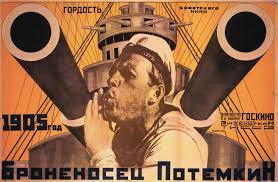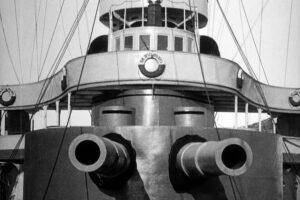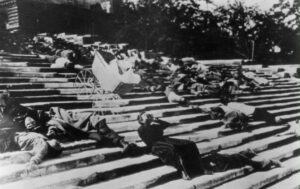“Battleship Potemkin” – a Masterpiece of Soviet Propaganda

Title: “Battleship Potemkin”
Release Date: 1925
Director: Sergei Eisenstein
Cast: Aleksandr Antonow, Władimir Barski, Grigorij Aleksandrow, Iwan Bobrow, Michaił Gomorow, Andriej Fajt, Władimir Uralski
“Battleship Potemkin”, Sergei Eisenstein’s best film, was made in 1925, on the occasion of the 20th anniversary of the 1905 Revolution. This work captivated the world and became an icon of Soviet avant-garde filmmaking. At the same time, “Battleship Potemkin” was a masterful propaganda move – it created the founding myth of communism as an idea that changes the face of an unjust reality.
“Battleship Potemkin”
Sergei Eisenstein was the most prominent experimenter within Soviet cinema. His most important formal achievements concerned discoveries in the field of editing. This director was the first to codify the concept of “intellectual montage”, which consisted in juxtaposing scenes from different orders: for example, the image of slaughtering cows with the pacification of a workers’ strike (“Strike”). The purpose of this juxtaposition was the intellectual conclusion the viewer was to draw from such a drastic association. In 1925 Eisenstein made his best silent film, “Battleship Potemkin”.
The date was not accidental – for the work was to commemorate the Revolution of 1905. For this purpose, the director chose a historical episode – the mutiny of Russian sailors against the commanders on the tsarist battleship. The rebellion of the crew began with their refusal to eat borscht prepared with spoiled meat. This and other elements of history were processed in the film with truly artistic virtuosity and subordinated to the main propaganda message of the film.

“Battleship Potemkin” – a tragedy in five acts
Watching “Battleship Potemkin” one cannot help but notice the perfect composition of the film. Eisenstein divided it into five parts, which are closed wholes with their own drama and two-part course of action. Such a structure of the film, as the director himself claimed, was taken from Greek tragedy, and what is more, it was supposed to reflect the order of nature. The sequence of events presented here has a definite order: it develops from exposition through increasing tension and catastrophe to the finale. The sailors, noticing the iniquity of the officers, take control of the battleship, and then transport the body of the killed leader of the mutiny, Grigory Vakulyuchuk, to Odessa.
The local population, shocked by the bestial murder of an innocent victim, takes the side of the crew and provides them with necessary provisions. Suddenly, however, Cossacks appear and massacre people on the Potemkin Stairs. Enraged battleship responds with fire. To suppress the mutiny other battleships and destroyers are called, but nobody shoots at the sailors and the battleship sails away to Romania without a single shot. The individual parts are separated by means of “film punctuation”, i.e. the procedures of dimming and brightening the image. They resemble the perspective of a telescope – alternately zooming in and out of the object of observation.
“Battleship Potemkin” – the mythology of revolution
It is worth paying attention to how Eisenstein builds the myth of the revolution under the red banners. The seemingly trivial issue of stale soup grows in the film to become a telling symbol of the oppression of the poorest layers of society. The vermin infesting the meat becomes an allegory for the corruption of the entire imperial order, which reaches its climax. The method of portraying the leader of the rebellion is also interesting: Vakulenchuk shot by the battleship commander becomes, as it were, the first martyr for the cause. His character is clearly stylized as the sacrifice of the Messiah. Vakulyuchuk’s body is put on public display with the caption: “killed for a plate of borscht” brings to mind the cross of Christ with the guilt inscribed over it: INRI. In addition, the weeping women leaning over it resemble Marie in mourning clothes deploring the death of Jesus.

Eisenstein clearly exposes the figure of Vakulenchuk and also juxtaposes him with the Battleship Potemkin himself – a symbol of the revolution. The film repeatedly invokes the musketeer ethic of solidarity, “One for all – all for one.” According to this motto, Vakulyuchuk makes a sacrifice for the freedom of the collective, while the crowd empathizes with him and confronts violence. The call of the Musketeers is paraphrased in one of the last scenes of the film, when the battleship is about to break through the cordon of destructive ships. For the caption then appears on the screen: “One on all – all on one”. It turns out, however, that the Russians do not want a fratricidal fight and refuse to shoot at the Potemkin – so the idea of solidarity, not combat, prevails.
The Odessa Staircase: Virtuosity and Ideological Falsification in “Battleship Potemkin”
The greatness of Eisenstein’s film lies not only in its compact, perfect composition and the mythologization of the depicted events. “Battleship Potemkin” went down in cinema history thanks to, among other things, the scene of the massacre of civilians on the Odessa steps. This extremely dramatic moment is the climax of the revolutionary tragedy. The stairs themselves are extremely important to the construction of the film. It is a clear signal of the film’s gradation of tension. Upstairs, behind unsuspecting people, a detachment of Cossacks appears. It is clear that in a moment something terrible will happen before our eyes. And indeed: the soldiers pacify innocent people in cold blood. No one is spared, but mostly women and small children die.
Eisenstein filmed this sequence masterfully, using an alternating rhythm of close-ups of the victims and camera raids on the death squadron marching in unison. The scenes on the Odessa stairs are a perfect balance between shots of the crowd and the individual. A baby carriage rolling down the stairs makes a bigger impression on the viewer than the deaths of thousands. This is a cinematic synecdoche – the part (the baby) replaces the whole (all the victims of the massacre). Additionally, the filming with upward camera movements exaggerates the effect and adds pathos to the whole scene.
This masterfully composed sequence has only one flaw – it has no motivation in the story. Eisenstein invented this massacre to give his work a propaganda value. The revolution (implicitly including the October Revolution) appears as the mythical founding act of communism. The revolution, in Eisenstein’s view, is a pure uprising of the simple people and righteous anger against their oppressors. Thus, “Battleship Potemkin” became a perfect ideological work, serving to reinforce Marxism-Leninism and extolling the red banner. It must be remembered, however, that in reality this banner was the sign of the destruction of millions of human lives.
J. Wojnicka, „Kino Rosji carskiej i Związku Sowieckiego”, [w:] „Kino nieme”, pod red. T. Lubelskiego, I. Sowińskiej i R. Syski, Kraków 2010.
J. Płażewski, „Język filmu”, Warszawa 1982.
